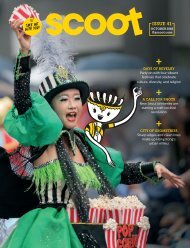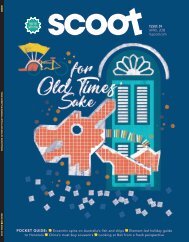July 2018 - Scoot In-flight Magazine
You also want an ePaper? Increase the reach of your titles
YUMPU automatically turns print PDFs into web optimized ePapers that Google loves.
ABOVE:<br />
The master’s<br />
bedroom is a<br />
popular spot<br />
among the<br />
visitors of the<br />
1730 Jesuit<br />
House.<br />
SPANISH<br />
AND CHINESE<br />
INFLUENCES<br />
1730 Jesuit House features coral<br />
stone walls and hardwood<br />
floors made of tugas or molave<br />
trees. The two-storey house was<br />
completed in 1730 to<br />
accommodate the Jesuit<br />
missionaries who were assigned<br />
in Parian, an area where Chinese<br />
merchants conducted trade<br />
with the locals. Astonishingly,<br />
these commercial transactions<br />
were already ongoing even<br />
before the team of navigator<br />
Ferdinand Magellan came to<br />
conquer the island and claimed<br />
to discover the archipelago.<br />
<strong>In</strong> 1768, the Jesuits were<br />
expelled from all of the<br />
territories where Spanish King<br />
Carlos III reigned, which included<br />
the Philippines. No reliable<br />
evidence proves what<br />
happened to the house after<br />
the religious order’s exile until<br />
the Alvarez family—originally<br />
from Spain—resided in the<br />
property. The Sy family then<br />
purchased it and transformed it<br />
into a warehouse in the 1960s.<br />
“My father originally bought<br />
this place to be used as a<br />
warehouse. He didn’t buy this<br />
house because of the house<br />
itself. He was interested in the<br />
compound because it was<br />
fenced,” recalls 68-year-old<br />
Jaime Sy, owner and founder of<br />
Museo Parian.<br />
His father, Nicanor, converted<br />
the open space into an area<br />
where he could store<br />
construction materials for his<br />
business, Ho Tong Hardware,<br />
and intentionally kept the house<br />
untouched. Jaime even<br />
remembered his dad telling him<br />
to preserve it because “this is<br />
memorabilia of the Chinese<br />
craftsmen who built it.”<br />
Even though it is believed that<br />
the Chinese were responsible<br />
for building the house—as<br />
observed through the wood<br />
construction, dragon tail details<br />
inside the rooms, and the clouds<br />
painted on the ceilings—it is still<br />
mainly influenced by the<br />
50 SCOOT










